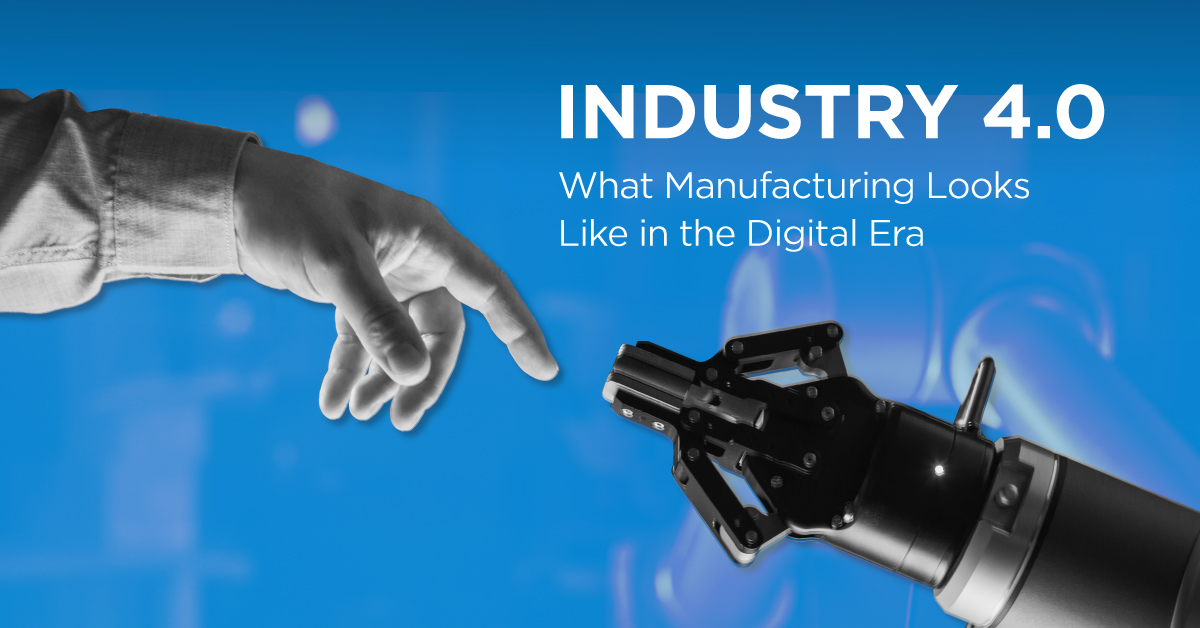Industry 4.0: What Manufacturing Looks Like in the Digital Era
The following content is sponsored by ASE Global

Industry 4.0: What Manufacturing Looks Like in the Digital Era
It might sound futuristic, but the Fourth Industrial Revolution—also known as Industry 4.0—has already begun.
Following the Industrial Revolution’s steam power, electrification in the 1800s, and the Digital Revolution of the late 20th century, Industry 4.0’s innovative smart technology is unlocking the next steps in automation.
So what does the next major evolution of manufacturing look like? This graphic from ASE Global breaks down the rollout of Industry 4.0, from increased robotization to lights-out manufacturing.
The Basics of Industry 4.0
Each industrial revolution has built on what came before, incorporating new technologies and knowledge of manufacturing. Industry 4.0 has four core principles paving the way:
- Interconnection: Machines, devices, sensors, and people in the manufacturing process all connecting and communicating with each other.
- Information transparency: Comprehensive data and information being collected from all points in the manufacturing process, allowing for more informed decisions.
- Technical assistance: Improved technological facility of systems assisting humans in decision-making, problem-solving, and difficult or unsafe tasks.
- Decentralized decisions: Cyber physical systems that are able to make decisions on their own and perform tasks autonomously.
Combining these principles is what makes the ongoing Fourth Industrial Revolution unique. Much of the underlying technology has been available for decades, including robotics and networks, but properly using them together unlocks a massive stride in manufacturing capabilities.
Already, the market size for Industry 4.0 specific technology was estimated to be $116.1 billion in 2021. By 2028, it’s projected to grow almost three times to $337.1 billion, with core components leading the way.
| Industry 4.0 Technologies | Components |
|---|---|
| Cyber physical systems | Machines (computer systems) controlled by algorithms. |
| Internet of things (IoT) | Network of machines exchanging data. |
| On-demand availability | Computer system resources that are able to be utilized at any time. |
| Cognitive computing | Systems with artificial intelligence that adapt, iterate, and improve over time. |
These technologies are already being rolled out in smart factories around the globe, and the most robust and up-to-date versions are being used to unlock the next evolution: lights-out manufacturing.
What is Lights-Out Manufacturing?
Where traditional factories and even smart factories require some direct human interaction, true lights-out factories operate completely autonomously.
Though it might sound like a dream, lights-out factories are fully automated, 24/7 factories with no on-floor human presence. And they already exist in the modern world.
Japanese robotics designer FANUC has been using robots to build themselves in a lights-out factory for 20 years, and even electronics company Philips uses 128 robots in a lights-out manufacturing line to produce electric razors.
One industry that uses lights-out manufacturing extensively is semiconductor manufacturing. ASE Global, the world’s leading provider of semiconductor manufacturing services in assembly and test, used 18 completely automated factories in 2020 alone.
Unlocking Lights-Out Factories
Different businesses and industries will be able to utilize Industry 4.0 technologies in different capacities, and lights-out manufacturing is no different.
Though incorporating fully autonomous factories can unlock huge potential, there are also significant challenges to first overcome.
| Effects of Lights-Out Factories | Opportunity Unlocked | Challenge to Unlocking |
|---|---|---|
| Cost | Savings on material, inventory and management costs. | Implementation requires purchasing machines, setting up the line, and working out early issues. |
| Efficiency | Products can be made more quickly and accurately with trained machines. | Significant changes to manufacturing (different products or setup) need to be made by humans. |
| Scale | Operations can continue uninterrupted for days or even weeks at a time. | Full utilization requires a large volume of products, usually interchangeable or modular. |
| Staff | Workers can be upskilled and better utilized outside of the factory floor, resulting in better wages and time management, and a safer working environment. | Skilled workers are needed to implement the factory, and they need to be continuously trained to keep up-to-date with improving technology. |
Which industries will implement lights-out manufacturing? New robot installations in 2019 show that the automotive, electronics, and metal and machinery sectors are unsurprisingly leading the way in Industry 4.0 implementation.
The Industry 4.0 Snowball Rollout
As 4.0 technology improves and costs decrease, the implementation of lights-out capabilities is expected to surge.
A global survey of businesses for their 2025 production plans show that 17% are anticipating having completely lights-out manufacturing, while 79% of manufacturing will be human-driven but digitally-augmented to some degree.
And like other industrial revolutions before, the technological rollout quickly creates a snowball effect that speeds its growth:
- Demand increases for cyber physical systems and smart machines.
- The supply of smart-capable machines with semiconductors increases.
- Bigger and more robust networks of machines are assembled.
- Improved capabilities further increase demand.
Many industries are capable of benefiting from 5G, IoT, and more robust usage of data and machines in some way. The question of when your sector will see Industry 4.0 is either sooner than you think, or it has already begun.
-

 Sponsored3 years ago
Sponsored3 years agoMore Than Precious: Silver’s Role in the New Energy Era (Part 3 of 3)
Long known as a precious metal, silver in solar and EV technologies will redefine its role and importance to a greener economy.
-

 Sponsored7 years ago
Sponsored7 years agoThe History and Evolution of the Video Games Market
Everything from Pong to the rise of mobile gaming and AR/VR. Learn about the $100 billion video games market in this giant infographic.
-

 Sponsored8 years ago
Sponsored8 years agoThe Extraordinary Raw Materials in an iPhone 6s
Over 700 million iPhones have now been sold, but the iPhone would not exist if it were not for the raw materials that make the technology...
-

 Sponsored8 years ago
Sponsored8 years agoThe Industrial Internet, and How It’s Revolutionizing Mining
The convergence of the global industrial sector with big data and the internet of things, or the Industrial Internet, will revolutionize how mining works.


